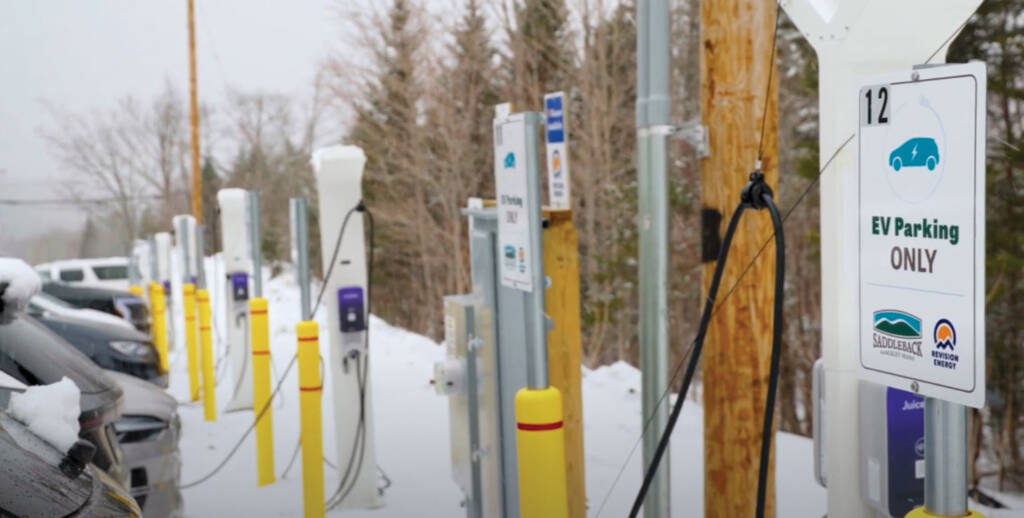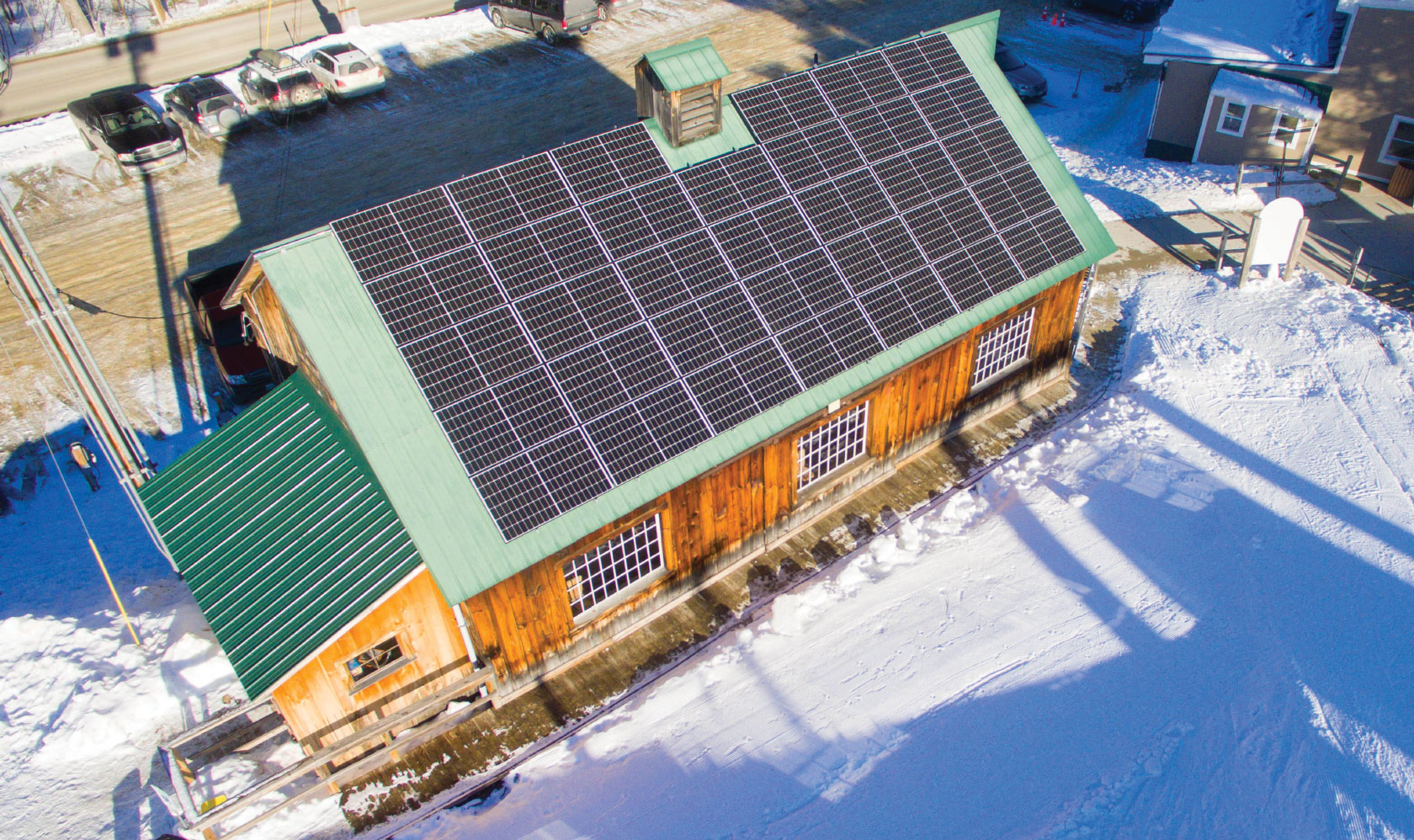Daniel Clapp remembers seeing an early 20th-century photograph of New York City’s Times Square, noting all the horses and buggies on the street. About a decade later, a second photograph of the same spot showed only one horse and buggy, the other vehicles were Model T’s.
It’s this type of transition that Clapp believes is now underway in the energy sector. As society transitions away from fossil fuels to renewable technologies, society is set to drastically innovate. As a co-founder of ReVision Energy, Clapp has helped lead companies and households into the solar energy transition and electric vehicle (EV) charging stations, and ski resorts are beginning to take notice.
Founded in 2003 as a small retail store, and based in South Portland, Maine, the company has spent more than 20 years installing solar projects throughout New England, including in Maine, New Hampshire, and Massachusetts. “The company was started by my partner, William Behrens, who ran The Green Store in Belfast, [Maine], selling renewable energy components,” said Clapp.
What began as a niche retail operation evolved into EnergyWorks and later ReVision Energy. Today, the solar company has more than 500 employee-owners across three states. The transition to employee-owned began in 2017 and helped position the company as a leader in renewable energy.
ReVision Energy’s journey into the ski resort industry was a natural progression, according to Clapp, who volunteers for the ski patrol at his local ski resort, Saddleback Ski Area & Bike Park in Maine.

“Being in northern New England, we are surrounded by ski resorts, which are a big part of the economy here,” he said. “Many of our employee-owners are outdoor enthusiasts involved in mountain biking, hiking and skiing, making the connection to ski resorts quite strong.”
The company has undertaken various solar projects for ski resorts for a wide variety of operators, which are tailored to meet each resort’s specific energy needs and unique operations.
“We’ve done anything from a rooftop donation for a non-profit ski club to a large solar [photovoltaic] ground-mounted array for a ski academy,” said Clapp.
Before embarking upon a solar or EV charging project, Clapp recommends that ski resorts consider several factors. One of the first considerations is understanding the ski resort or area’s sustainability goals and prioritizing initiatives accordingly. Ski resorts cater to outdoor enthusiasts who value clean air, so it is important to demonstrate a commitment to reducing carbon emissions.
Financial incentives are another important part of the decision-making process. Each jurisdiction has different incentive programs to increase the uptake of solar and EV technology. The U.S. Inflation Reduction Act (IRA) supports investments in combating climate change, and there are a variety of other state-specific incentives that can significantly reduce upfront costs.
It is also crucial to evaluate the financial implications, including potential savings and payback periods, which can range from three to 10 years based on the price of electricity, incentives and net metering policies in the specific state.
“The great thing about this is that it works from a financial perspective,” said Clapp. “These assets pay for themselves and you will get a return on your investment, but it is also critical to connect the dots that this is an outdoor recreation industry, and that outdoor recreation is not going to exist unless we transition to clean energy.”
He says that as EV adoption continues to increase, more charging stations will be required. Resorts will need to provide these stations as the energy transition continues.
Ownership models
Resorts should also consider different ownership models if they do not have the capital readily available to invest. Third-party ownership can make solar installations financially feasible and provisions can be made for the resort to assume ownership.
“Stay open-minded about the ownership structures to get this technology to your resort and reduce your carbon footprint,” Clapp said. “It doesn’t have to be on your balance sheet. A lot of the time, it makes sense to [do it] because the financials will provide a good payback while displaying your commitment, but you can still see savings through third-party ownership structures.”
Those interested in third-party agreements should speak to reputable companies that can provide a range of options and have a keen understanding of what is involved. ReVision Energy is also part of Amicus Solar Cooperative, which pools resources for collective buying and shares resources on governance, strategy and best practices for implementing solar solutions. All member companies have a strong reputation in their local market.

The process of installing a solar array at a ski resort involves several steps. Initially, an energy load analysis is conducted to assess the resort’s electrical consumption. “We look at the entire energy load to see where you can transition to solar-based systems,” said Clapp.
Following the load analysis, the next step is to determine the available space for solar installations. Rooftop arrays are often preferred as they showcase the technology to customers, but ground-mounted arrays or carports with integrated EV chargers can provide additional capacity. Typically, it’s a balancing act between the available space, the point of interconnection and the size of the electrical infrastructure to build an appropriately sized solar array.
The timeline from initial contact to solar generation usually spans about 12 to 18 months, depending on various factors, most notably the interconnection process with local utilities.
Net metering policies
One common concern with solar energy is its intermittent nature. Clapp says that net metering policies allow for the excess energy generated during sunny periods to be credited against the energy consumed when the sun is not shining. As well, continuing advancements in battery storage technology offer promising solutions.
“As batteries continue to come down in cost, more facilities will adopt battery storage to complement their solar arrays,” he said.
While current battery storage solutions can be cost-prohibitive at some resorts, they provide an essential backup during power outages and help manage energy loads more efficiently.
The renewable energy sector is continually evolving, with advancements in solar modules, battery storage and EV charging technology. Clapp emphasized the dynamic nature of the industry, and advised ski resorts to stay informed about emerging technologies and policy changes.
“It’s a balance between taking action now and staying adaptable to future advancements, but with the current financial incentives in place, now is a great time to take advantage of them and explore your options to transition to renewables and save on your operation expenses. Your customers will surely notice because they want to see ski resorts being the example,” he said.


